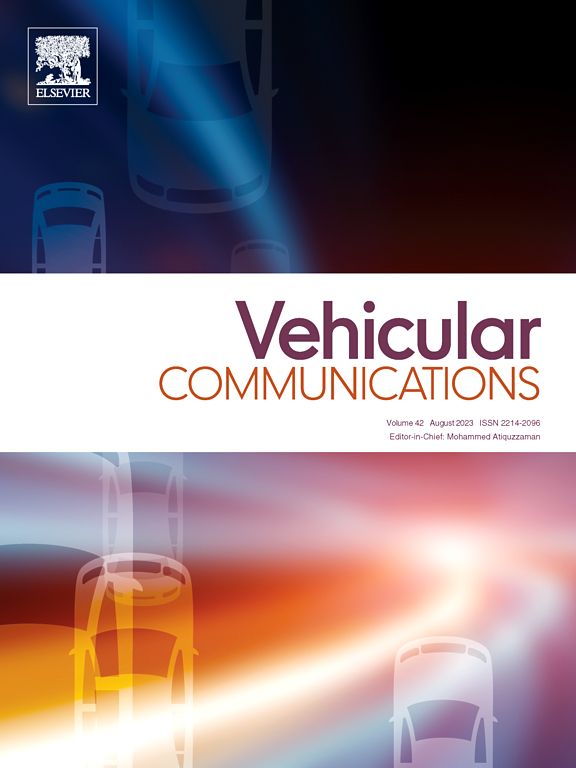Optimizing road side units connectivity in intelligent transportation systems with optical network solutions
IF 6.5
2区 计算机科学
Q1 TELECOMMUNICATIONS
引用次数: 0
Abstract
A fundamental component of Intelligent Transportation Systems (ITS) is connectivity. For connected vehicles to be aware of events occurring nearby, or even far from them, roadside infrastructure is essential. Roadside Units (RSUs) are electronic equipment placed along highways to provide connectivity and share data with vehicles, other RSUs, and networks. Connected vehicles require wireless communication with RSUs; however, depending on the complexity of tasks and the number of users, spectrum resources may be insufficient to handle all required communication between vehicles, RSUs and external networks. Since RSUs are stationary, optical fiber is an ideal technology for interconnecting them and linking them to the Internet and the cloud, providing reliable, high-performance connectivity, with low signal attenuation and high bandwidth. This paper proposes a model for deploying fiber networks to connect RSUs, with a focus on minimizing capital expenditures, including costs for civil works, cables, and devices, which are critical considerations given the large distances involved. Specifically, we consider and compare two established optical network technologies: point-to-point (PtP) and passive optical networks (PON). To support this comparison, we present and test two novel Integer Linear Programming (ILP) formulations: one for PtP and one for PON. Additionally, we introduce a genetic algorithm that improves upon a previously proposed heuristic, achieving near-optimal results comparable to the ILP formulation, while efficiently solving large-scale scenarios. The results show that the optimal choice between PtP and PON depends on the deployment area and density of RSUs.
利用光网络解决方案优化智能交通系统中道路侧单元的连接
智能交通系统(ITS)的一个基本组成部分是连通性。为了让联网车辆了解附近甚至远处发生的事件,路边基础设施是必不可少的。路边单元(rsu)是放置在高速公路沿线的电子设备,用于与车辆、其他路边单元和网络提供连接和共享数据。联网车辆需要与rsu进行无线通信;然而,根据任务的复杂性和用户的数量,频谱资源可能不足以处理车辆、rsu和外部网络之间所需的所有通信。由于rsu是固定的,因此光纤是将它们互连并连接到互联网和云的理想技术,提供可靠、高性能的连接,具有低信号衰减和高带宽。本文提出了一个部署光纤网络连接rsu的模型,重点是最小化资本支出,包括土建工程、电缆和设备的成本,这是考虑到所涉及的大距离的关键考虑因素。具体来说,我们考虑并比较了两种已建立的光网络技术:点对点(PtP)和无源光网络(PON)。为了支持这种比较,我们提出并测试了两个新的整数线性规划(ILP)公式:一个用于PtP,一个用于PON。此外,我们引入了一种遗传算法,该算法改进了先前提出的启发式算法,实现了与ILP公式相当的接近最优结果,同时有效地解决了大规模场景。结果表明,PtP和PON的最优选择取决于rsu的部署面积和密度。
本文章由计算机程序翻译,如有差异,请以英文原文为准。
求助全文
约1分钟内获得全文
求助全文
来源期刊

Vehicular Communications
Engineering-Electrical and Electronic Engineering
CiteScore
12.70
自引率
10.40%
发文量
88
审稿时长
62 days
期刊介绍:
Vehicular communications is a growing area of communications between vehicles and including roadside communication infrastructure. Advances in wireless communications are making possible sharing of information through real time communications between vehicles and infrastructure. This has led to applications to increase safety of vehicles and communication between passengers and the Internet. Standardization efforts on vehicular communication are also underway to make vehicular transportation safer, greener and easier.
The aim of the journal is to publish high quality peer–reviewed papers in the area of vehicular communications. The scope encompasses all types of communications involving vehicles, including vehicle–to–vehicle and vehicle–to–infrastructure. The scope includes (but not limited to) the following topics related to vehicular communications:
Vehicle to vehicle and vehicle to infrastructure communications
Channel modelling, modulating and coding
Congestion Control and scalability issues
Protocol design, testing and verification
Routing in vehicular networks
Security issues and countermeasures
Deployment and field testing
Reducing energy consumption and enhancing safety of vehicles
Wireless in–car networks
Data collection and dissemination methods
Mobility and handover issues
Safety and driver assistance applications
UAV
Underwater communications
Autonomous cooperative driving
Social networks
Internet of vehicles
Standardization of protocols.
 求助内容:
求助内容: 应助结果提醒方式:
应助结果提醒方式:


